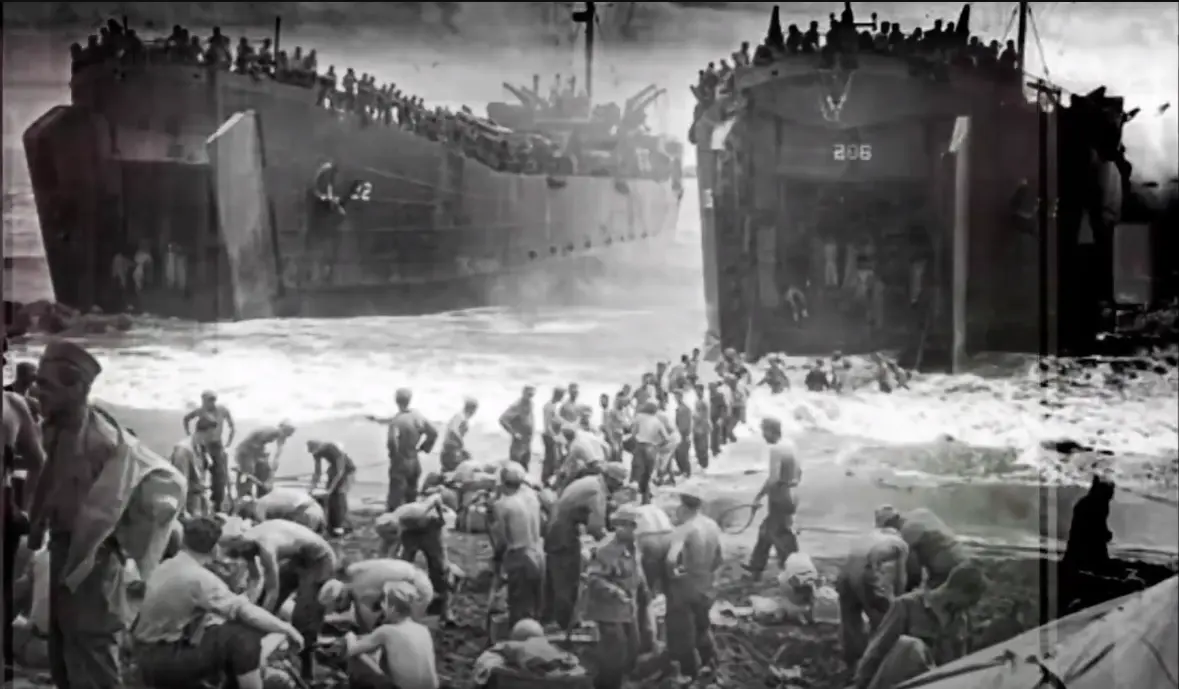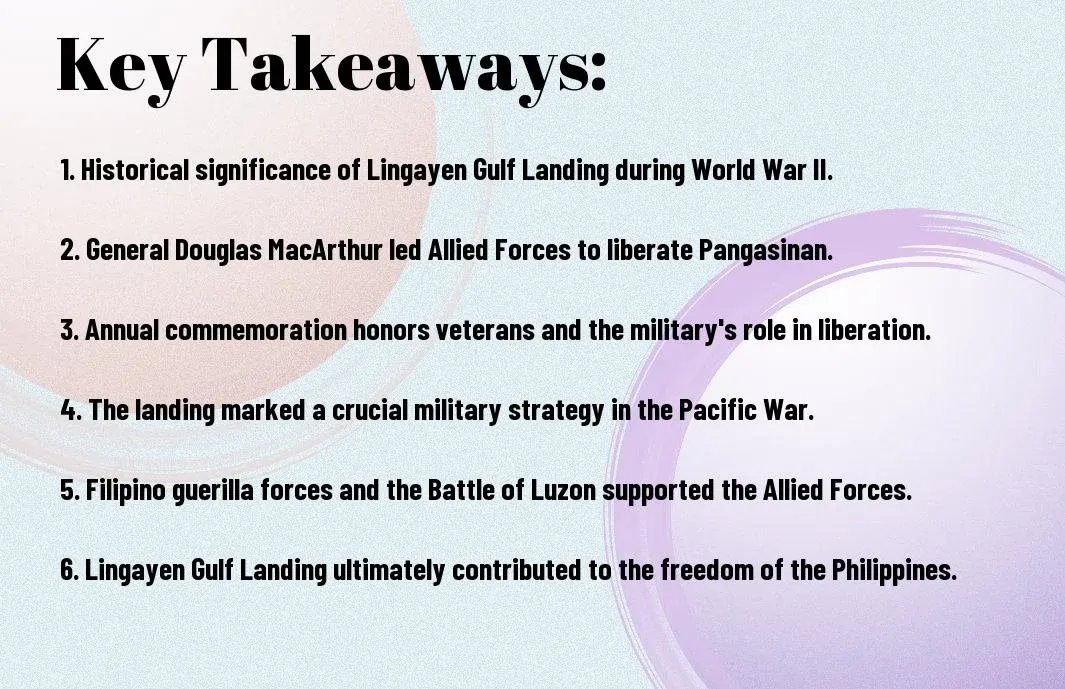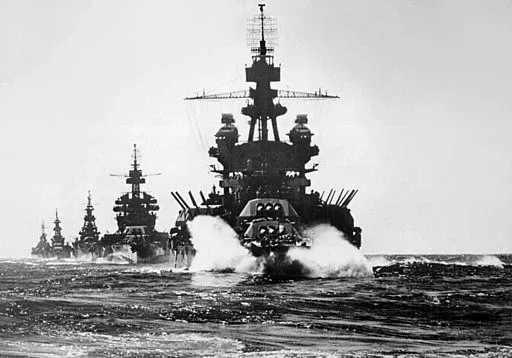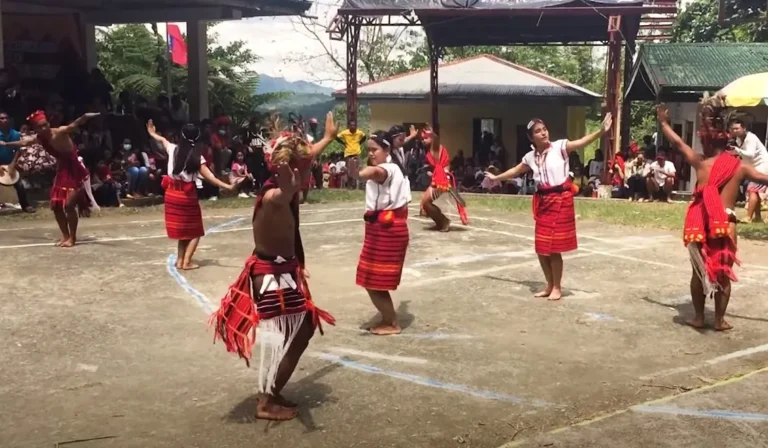Lingayen Gulf Landing Anniversary

On January 9, 1945, during World War II, General Douglas MacArthur and the Allied Forces launched a daring invasion of Pangasinan, on the shores of Lingayen, Philippines. This bold move marked the beginning of the liberation of the Philippines and played a crucial role in turning the tide of the war in the Pacific.
Amidst war, violence, and destruction, the Lingayen Gulf Landing symbolizes the heroism and sacrifice of countless veterans who fought for freedom. The strategic military maneuver orchestrated by MacArthur and Dwight D.
Eisenhower not only challenged the Japanese Empire but also provided support to the Second Philippine Republic and Filipino guerilla forces in the Battle of Luzon.
The joint efforts of the United States Army and United States Navy at Lingayen Gulf marked a significant turning point in the war, ultimately leading to the defeat of the Japanese forces and the liberation of the Philippines.

Facts About The Lingayen Gulf Landing Anniversary
| Facts | Explanation |
|---|---|
| Name of the Festival | Lingayen Gulf Landing Anniversary |
| Type of Festival | Historical commemoration |
| City of Origin | Lingayen, Pangasinan, Philippines |
| Festival Etymology | The festival is named after the Lingayen Gulf, a large body of water in the northern part of the Philippines where the landing of Allied forces took place during World War II. |
| Date Celebrated First | January 9, 1945 |
| Founder of the Festival | No specific founder – The Lingayen Gulf Landing Anniversary is a commemoration of the landing of the Allied forces in Lingayen Gulf during World War II. It is a collective remembrance of the historical event by the people of Lingayen and the Philippines. |
| Brief History of the Festival | The Lingayen Gulf Landing Anniversary commemorates the successful amphibious landing of the Allied forces on January 9, 1945. It marked a significant turning point in World War II, as it led to the liberation of the Philippines from Japanese occupation. The landing involved a joint effort by American and Filipino troops, who strategically entered Lingayen Gulf to establish a beachhead and launch their offensive against the Japanese forces. The anniversary celebration serves as a reminder of the sacrifices made by those who fought for freedom during the war. |
| Brief History of the City | Lingayen is a coastal town in the province of Pangasinan, Philippines. It has a rich history dating back to pre-colonial times when it was a thriving trading center. The town played a significant role during the Spanish colonial period and later became an important site during World War II. Lingayen was chosen as the landing site for the Allied forces due to its strategic location and natural harbor. Today, it is known for its beautiful beaches, historical landmarks, and vibrant culture. |
| Ethnic Information | Majority: Pangasinense; Minority: Ilocano, Tagalog, Visayan, Chinese |
| Location of the City | Lingayen, Pangasinan, Philippines |
| How to Reach the City | By air: The nearest airport is Clark International Airport in Angeles City. From there, take a bus or private transportation to Lingayen. By land: Lingayen is accessible by bus or private vehicle from Metro Manila. The journey takes approximately 4-5 hours depending on traffic conditions. By sea: There are no direct ferry services to Lingayen. However, nearby ports such as Dagupan and San Fernando can be accessed by ferry from other parts of the Philippines. From there, take a short land trip to reach Lingayen.** |
| Nearby and Surrounding Cities/Towns | – Dagupan City (approximately 12 km) – San Fernando City (approximately 30 km) – Manaoag (approximately 35 km) – Urdaneta City (approximately 40 km) – Alaminos City (approximately 45 km)** |
| Festival Main Events and Activities | – Wreath-laying ceremony at the Veterans Memorial Park – Parades showcasing historical reenactments – Exhibitions featuring artifacts and photographs from World War II – Cultural performances highlighting local traditions and dances – Fireworks display – Sports competitions – Food festivals showcasing local cuisine – Live music performances and entertainment – Historical talks and lectures about the significance of the Lingayen Gulf Landing Anniversary |
| Other Famous Tourist Attractions | – Lingayen Beach – A scenic beach along Lingayen Gulf that offers white sand, clear waters, and beautiful sunset views. – Capitol Building – A historic government building known for its distinct architecture and beautiful gardens. – Aguedo Agbayani Park – A well-maintained park with lush greenery, playgrounds, and recreational facilities. – Our Lady of Manaoag Church – A revered Catholic church known for its miraculous image of the Virgin Mary and attracts devotees from all over the country. – Bolinao Falls – A series of cascading waterfalls located in nearby Bolinao, offering a refreshing nature experience.** |
| Famous Food Dishes of the City | – Pigar-pigar – A popular stir-fried beef dish – Bangus (Milkfish) – Known as the “Fish Capital of the Philippines,” Lingayen is famous for its deliciously prepared bangus dishes. – Binungey – A traditional sticky rice cake wrapped in banana leaves – Kaleskesan – A savory soup made with beef tripe and vegetables – Calasiao Puto – Small rice cakes made from ground glutinous rice served with grated coconut on top** |
| Landmarks in the City | – Veterans Memorial Park – A tribute to the fallen soldiers during World War II – Lingayen Municipal Hall – An iconic government building with Spanish-inspired architecture – Lingayen Church (St. Peter and Paul Parish Church) – A historic church that dates back to the Spanish colonial era – Lingayen Capitol Building – The seat of government for Pangasinan province – Lingayen Public Market – A bustling marketplace where locals and tourists can buy fresh produce and local products |
| Related Festivals in the Same Region | – Hundred Islands Festival (Alaminos City) – Pista’y Dayat (Sea Festival) (Dagupan City) – Pistay Balangaw (Urdaneta City) – Pindang Festival (Manaoag) – Bangus Festival (Dagupan City) |
Historical Context

The anniversary of the Lingayen Gulf landing is celebrated to commemorate the Allied victory in the Philippines during World War II. The amphibious operation, which took place from January 6 to January 9, 1945, marked a significant turning point in the war.
It led to the successful landing of a large Allied force, commanded by Admiral Jesse B. Oldendorf and General Douglas MacArthur, on the shores of Lingayen from Lingayen Gulf, on the island of Luzon.
This operation played a crucial role in driving out Japanese forces and securing the region for the Allied powers. The anniversary serves as a reminder of the bravery and sacrifice of those involved in the operation and honors the memory of the lives lost during this pivotal moment in history.
Prelude to the Lingayen Gulf Landing
The stage for the Allied Forces’ assault on the shores of Lingayen Gulf was set after a series of strategic movements and battles. The Japanese had captured the Philippines in 1942, prompting General Douglas MacArthur’s infamous promise to return.
The Allied Forces spent years planning and preparing for their return, and the invasion of Lingayen Gulf was a critical component of this broader strategy.
The intense anticipation and extensive logistical efforts leading up to the landing were immense, and the success of the operation would be essential for the eventual liberation of the Philippines.
Global Strategies and the Pacific War
As you delve into the historical context of the Lingayen Gulf landing, it’s crucial to consider the broader global strategies and the Pacific War.
The conflict was a massive undertaking, with the United States leading the Allied Forces against the formidable Japanese Empire. The Pacific War saw some of the most ferocious and hard-fought battles of World War II, with diverse military strategies and tactics deployed across the vast expanse of the Pacific Ocean.
The Lingayen Gulf landing was just one piece of the larger puzzle of the Pacific War, but its significance cannot be overstated.
The Japanese Empire and its Goals
Understanding the goals and motivations of the Japanese Empire provides critical context for the events at Lingayen Gulf. The Empire had expansionist ambitions in the Pacific region, seeking to establish dominance and control over vast swaths of territory.
Their occupation of the Philippines and other strategic locations was part of this broader goal, and their tenacity in defending these positions had a profound impact on the course of the war.
The Japanese Empire’s relentless determination to hold onto its conquered territories made the liberation struggle all the more challenging and costly for the Allied Forces.
Filipino Resistance and Guerilla Warfare
The Filipino people played a crucial role in resisting the Japanese occupation and supporting the Allied Forces through guerilla warfare.
Despite the immense challenges and dangers, Filipino resistance fighters and guerilla forces conducted covert operations, sabotage, and intelligence gathering, contributing significantly to the eventual success of the Allied campaign.
Their unwavering commitment to their country’s freedom and the sacrifices they made should not be underestimated in the historical context of the Lingayen Gulf landing and the wider Pacific War.
The Lead-Up to the Liberation
Now, let’s dive into the historical lead-up to the momentous occasion of the Lingayen Gulf Landing. As World War II raged on, the Japanese Empire seized control of the Philippines, subjecting the nation to years of occupation, violence, and suffering.
The Filipino people, alongside Allied Forces, yearned for liberation, and Pangasinan and the rest of the Philippines awaited their chance to break free from the clutches of the Japanese Empire.
General Douglas MacArthur and His Vow
General Douglas MacArthur, a central figure in the Pacific theater of World War II, made a vow to return to the Philippines after the country fell to the Japanese in 1942.
He declared, “I shall return,” and his determination and unwavering commitment to fulfill this promise became a symbol of hope and resilience for the Filipino people and Allied Forces alike.
MacArthur’s vow fueled the Allied efforts to plan and execute the liberation of the Philippines, with the eventual landing at Lingayen Gulf serving as the fulfillment of his promise.
The Role of the Allied Forces in the Pacific
The Allied Forces, comprising the United States Army, United States Navy, and Filipino guerilla forces, played a pivotal role in the Pacific War and the eventual liberation of the Philippines. Led by prominent figures such as General Dwight D.
Eisenhower and General Douglas MacArthur, the Allied Forces coordinated a multifaceted approach to combat the Japanese Empire, utilizing military strategy, intelligence operations, and collaborative efforts with local resistance groups to weaken the enemy’s hold on the region.
Preparations for the Lingayen Gulf Assault
In the lead-up to the Lingayen Gulf landing, extensive preparations were made by the Allied Forces to ensure the success of the assault. The meticulous planning involved strategic reconnaissance, logistical coordination, and the mobilization of troops and equipment to execute the amphibious operation.
The scale of the preparations underscored the significance of the impending assault on Lingayen Gulf, which would mark a crucial turning point in the Pacific War.
| Aspect | Details |
|---|---|
| Date | 3–13 January 1945 |
| Location | Lingayen Gulf, Luzon, Philippines |
| Result | Allied victory |
| Belligerents | United States, Commonwealth of the Philippines, Australia, Japan, Second Philippine Republic |
| Commanders and leaders | Jesse B. Oldendorf, Douglas MacArthur, Walter Krueger, Tomoyuki Yamashita |
| Strength | 875+ warships, 203,608 soldiers, roughly 450–600 aircraft, 262,000 troops on Luzon |
| Casualties and losses | US: 24 ships sunk, 67 ships damaged, 8,000 dead, 29,560 wounded; Japan: roughly 450–600 aircraft lost, 1 destroyer sunk, 2 damaged, Lingayen Invasion: 217,000 dead, 9,050 taken prisoner |
| Overview | Allied amphibious operation in the Philippines during World War II. U.S. Navy and Royal Australian Navy warships bombarded suspected Japanese positions along the coast for three days before the U.S. 6th Army landed on a roughly 25 mi beachhead at the base of the Gulf between the towns of Lingayen and San Fabian. The assault forces quickly captured the coastal towns and secured the 20-mile-long beachhead. Kamikaze attacks caused heavy losses to the Allied forces and ships. The battle saw significant casualties and damage to allied ships. Lingayen Gulf was turned into a vast supply depot for the rest of the war to support the Battle of Luzon. General Douglas MacArthur was embarked on the light cruiser USS Boise, which was attacked but managed to avoid hits during the operation. The battle resulted in the deaths of around 738 and the wounding of 1282 ship-based seamen, marines, and infantry. |
Military Strategy and Allied Plans
The military strategy employed by the Allied Forces for the assault on Lingayen Gulf was characterized by precision, coordination, and decisive action.
The intricate planning and execution of the amphibious landing aimed to catch the Japanese forces off-guard, utilizing strategic deception and overwhelming firepower to gain the upper hand.
The Allied plans incorporated lessons learned from previous engagements and a deep understanding of the local terrain and conditions, demonstrating a clear focus on achieving a swift and impactful victory in the liberation of Pangasinan and the Philippines.
The Lingayen Gulf Landing
To commemorate the historical significance of the Lingayen Gulf Landing Anniversary, it is essential to delve into the details of the operation that took place on January 9, 1945.
As one of the most pivotal moments during World War II, the landing at Lingayen Gulf marked the beginning of the liberation of the Philippines and played a crucial role in turning the tide of the Pacific War in favor of the Allied Forces.
Location Of Lingayen In The Philippines
The Execution of the Landing on January 9, 1945
The successful execution of the landing at Lingayen Gulf on January 9, 1945, was a meticulously planned and coordinated effort by the Allied Forces.
Under the leadership of General Douglas MacArthur, the operation involved a massive amphibious assault on the beaches of Lingayen in Pangasinan, Philippines.
The objective was to establish a strategic foothold on the island of Luzon and pave the way for the eventual liberation of the entire country from the clutches of the Japanese Empire.
Naval and Air Operations in the Gulf
The naval and air operations that supported the landing at Lingayen Gulf were extensive and played a crucial role in ensuring the success of the mission.
The Allied Forces assembled a massive fleet of ships and aircraft to provide cover and support for the amphibious assault.
The naval bombardment and aerial strikes targeted Japanese defenses and prepared the way for the landing forces to make their approach to the shores of Lingayen.
Opposition by the Japanese Empire and the Second Philippine Republic
The opposition faced by the Allied Forces during the Lingayen Gulf Landing was fierce and relentless. The Japanese Empire and the Second Philippine Republic had fortified their positions and were prepared to defend the beaches at all costs.
The landing forces encountered heavy resistance, including artillery fire, mines, and infantry attacks as they fought to establish a beachhead and push inland.
Role of United States Army and Navy
The role of the United States Army and Navy in the Lingayen Gulf Landing was instrumental in overcoming the challenges posed by the enemy forces.
The bravery and determination of the soldiers and sailors who stormed the beaches and supported the assault with firepower and logistics were crucial to the success of the operation.
Their unwavering commitment to the mission and each other in the face of danger and adversity reflected the highest ideals of military service.
The Battle of Luzon and Beyond
Keep in mind that after successfully landing in Lingayen Gulf, the Allied Forces faced the challenging task of advancing towards Manila and liberating the Philippines from the Japanese Empire.
The Battle of Luzon was a critical phase of the Pacific War, and it marked a turning point in the fight for freedom and the defeat of the Japanese forces in the region.
Advancement From Lingayen Gulf to Manila
As the Allied Forces advanced from Lingayen Gulf towards Manila, they encountered fierce resistance from the Japanese forces. The battle was marked by intense fighting and strategic military maneuvers.
Your indomitable spirit and courage were crucial in overcoming these challenges and pushing forward toward the liberation of the Philippines.
Key Battles and Turning Points
Throughout the campaign to liberate Luzon, there were several key battles and turning points that played a pivotal role. The battles of Bataan, Corregidor, and the recapture of Manila were significant milestones in the Allied Forces’ relentless push toward victory.
These hard-fought battles demonstrated unwavering determination and commitment to securing freedom and justice.
Liberation of the Philippines
The liberation of the Philippines was a monumental achievement that reflected the extraordinary bravery and sacrifice of the Allied Forces.
Unwavering dedication to the cause of freedom and democracy paved the way for the eventual defeat of the Japanese Empire in the Pacific and the restoration of peace in the region.
The liberation of the Philippines stands as a testament to the valiant efforts and sacrifices made by all those who fought for the cause of liberty.
Contributions of Filipino Guerrilla Forces
The contributions of Filipino guerrilla forces were instrumental in the success of the Allied Forces’ campaign in the Philippines. Resilience, resourcefulness, and unwavering commitment to the liberation effort significantly augmented the Allied military strategy.
The Filipino guerrilla forces played a crucial role in gathering intelligence, conducting sabotage operations, and providing vital support to the advancing Allied troops, ultimately hastening the defeat of the Japanese forces in the region.
The Effects of the Lingayen Gulf Landing
Unlike previous battles in the Pacific War, the Lingayen Gulf Landing had significant effects on both the military and civilians. The strategic importance of the landing and the subsequent events shaped the course of the war and had a profound impact on the people involved.
Casualties, Violence, and Destruction
The battle at Lingayen Gulf resulted in heavy casualties, widespread violence, and extensive destruction. The intense fighting led to a high number of casualties among both the Allied Forces and the Japanese Empire.
The sheer scale of violence and the devastation caused by the battle left a lasting impact on the region and its inhabitants. The sacrifices made by the soldiers and the civilian population cannot be overstated, underscoring the brutality and harsh reality of war.
Psychological Impact on Soldiers and Civilians
The Lingayen Gulf Landing also had a profound psychological impact on both the soldiers and the civilian population. The trauma and stress experienced by those involved in the battle left lasting scars, with many struggling to come to terms with the horrors they witnessed.
PTSD and other mental health issues became prevalent among soldiers, while civilians grappled with the fear and uncertainty brought about by the conflict.
Shifts in Military Momentum
The successful landing at Lingayen Gulf marked a significant shift in military momentum in the Pacific War. With the Allied Forces gaining a foothold in the region, the balance of power began to tilt in their favor.
This pivotal moment had far-reaching consequences, ultimately paving the way for advancements toward the liberation of the Philippines and the eventual defeat of the Japanese Empire.
Path to the End of World War II in the Pacific
The Lingayen Gulf Landing played a crucial role in shaping the path to the end of World War II in the Pacific. The successful invasion set off a series of events that would ultimately lead to the liberation of the Philippines and the eventual surrender of the Japanese Empire.
The strategic significance of the landing and the subsequent military operations highlighted the determination and resolve of the Allied Forces, ultimately bringing about the end of the war in the Pacific.
Remembering the Lingayen Gulf Landing
Not only is the Lingayen Gulf Landing anniversary a significant historical event, but it also holds a special place in the hearts of many people.
This momentous occasion marks the beginning of the liberation of the Philippines during World War II, a bold and strategic move that changed the course of history in the Pacific theater.
Honoring the Veterans and Heroes
It is essential to remember and honor the brave veterans and heroes who fought in the Battle of Lingayen Gulf. These individuals demonstrated unmatched courage and resilience in the face of danger, and their contributions should never be forgotten.
By recognizing their sacrifices and unwavering dedication, we pay tribute to their invaluable service to our country and the cause of freedom.
Memorials and Commemorative Events
Memorials and commemorative events play a crucial role in preserving the memory of the Lingayen Gulf Landing and honoring the individuals who took part in this historic event.
These gatherings provide an opportunity for the community to come together and pay their respects to the veterans and heroes who played a pivotal role in the liberation of the Philippines.
It is through these events that the sacrifices made during the war are remembered and cherished for generations to come.
Lingayen Gulf in Philippine History and Education
The Lingayen Gulf holds significant historical significance in the Philippines and serves as an important educational opportunity for younger generations.
By learning about the events that unfolded during the Lingayen Gulf Landing, individuals gain a deeper understanding of the impact of World War II on the country and the sacrifices made by those who fought for freedom.
Reflections on Freedom and the Price Paid
Reflecting on the events of the Lingayen Gulf Landing allows us to recognize the immense price that was paid for the freedom we cherish today. It serves as a powerful reminder of the sacrifices made by countless individuals who fought for the liberation of the Philippines.
Their bravery and determination in the face of adversity exemplify the true cost of freedom, and it is important to acknowledge and honor their enduring legacy.
Conclusion
Considering all the points discussed, the Lingayen Gulf Landing Anniversary holds great historical significance as it marks the pivotal moment in World War II when General Douglas MacArthur and the Allied Forces successfully liberated Pangasinan and Lingayen.
This event commemorates the bravery and sacrifice of the veterans who fought for freedom in the Philippines, and it serves as a reminder of the heroism and military strategy employed during the Pacific War.
The anniversary also honors the resistance of Filipino guerilla forces and the ultimate defeat of the Japanese Empire, leading to the restoration of peace and sovereignty in the region.
As we commemorate the Lingayen Gulf Landing Anniversary, it is important to acknowledge the violence, death, and destruction that occurred during the Battle of Luzon. It is a testament to the resilience and courage of those who fought in the face of adversity.
The legacy of the landing serves as a reminder of the profound impact of war and the ultimate triumph of freedom and liberation. Let us continue to honor the memory of those who served and pay tribute to their enduring legacy.





